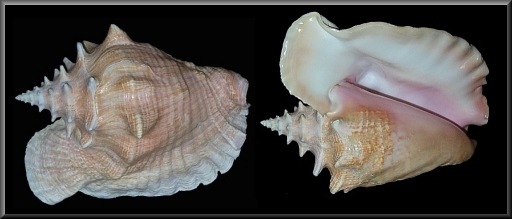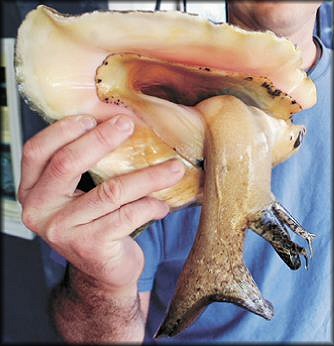Who Counts The Conchs? |
|
By Bill Frank |
 |
| Adult specimen from the Florida Keys (245 mm.) |
| Without a doubt, the Pink
Conch, or, if you prefer, the Queen Conch (Lobatus gigas
(Linnaeus, 1758)) is Florida's most
well-known shell. Empty shells may be found for sale virtually
everywhere. Live specimens are somewhat harder to find. Because the Pink Conch is valued as a food item, we know a lot about them - such as that their range extends through the Caribbean Sea, north to southern Florida, the Bahamas and Bermuda. Occasionally they have been found as far up the U.S. East Coast as North Carolina. Although usually a resident of shallow water, specimens have been reported living in depths up to 480 feet. A female conch will lay approximately six egg masses each season with each containing anywhere from 250,000 to 750,000 eggs. After hatching in about three days into free-swimming veligers, the newborn float and otherwise move about in the sea for about three weeks before settling to the bottom and undergoing metamorphosis to the form which we are familiar. To summarize, they have a very wide distribution, live at depths well past sane SCUBA diving depths, produce large numbers of eggs, and have a long planktonic stage, which aids distribution. Also, they frequently bury themselves in the sand and live in colonies of like age groups. Now that we know our conch, the task is to determine how many adult conchs inhabit the waters of Monroe County (The Keys), The Bahamas' Grand Bank, and Puerto Rico. Impossible you say! Apparently not according to a September 8, 1993 Associated Press article in The Orlando Sentinel quoted below. "LONG KEY - Scientists seeking to rebuild the Key's dwindling Queen Conch population have released 500 of the prized and protected mollusks into the wild. Now they must determine how the laboratory-bred and raised conchs fare against water pollution and natural predators in the waters around the Keys.
The program came into being in response to decades of over-fishing and growing pollution of Keys waters, which are blamed for decreasing the local population to just 110,000 adults. That drastic reduction in the waters off Monroe County - which proudly touts itself as the Conch Republic - brought a 1985 ban on conch collecting. That ban was largely the work of Keys native and former state Rep. Joe Allen, who also helped get money for Glazer's studies. In the Keys, the conch's pink-lipped shell graces the Monroe County seal, and its meat was once a staple at local restaurants. But the once-common water snails are now a rarity. By comparison, Puerto Rico - which is considered heavily over-fished - has 10 times as many Queen Conchs. The Bahamas' Grand Bank has 40 times the population density as the Keys. On Long Key, Glazer originally ran into trouble trying to keep large numbers of young conchs alive. But after installing water purifiers at his lab on Florida Bay, he found he can grow in three weeks what used to take him six months. That discovery led him to suspect near-shore problems caused by poor sewage treatment has been one of the principal culprits killing conchs in his lab - and in Keys waters. But there are other threats to the conch, the biologist notes. One is algae blooms, which have become more frequent in recent years. Another threat comes from spells of unusually warm water. All of the 500 conchs released last week were tagged to enable researchers to monitor their travels and survival." |
 About 10,000 laboratory-raised Queen Conchs may be released under the program
next spring, biologist Bob Glazer said. He is directing the 6-year-old conch
project based at the former Sea World shark institute on Long Key.
About 10,000 laboratory-raised Queen Conchs may be released under the program
next spring, biologist Bob Glazer said. He is directing the 6-year-old conch
project based at the former Sea World shark institute on Long Key.